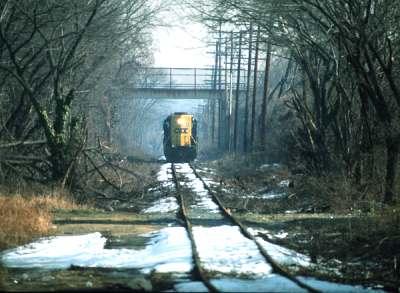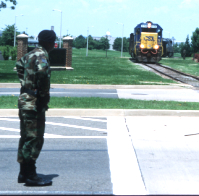The Baltimore & Ohio was the first railroad to serve Washington, D.C., completing a branch from its main line at Relay, Md., in August 1835.
To reach markets south of the nation’s capital, the B&O obtained permission to use the government bridge across the Potomac River, thereby giving the railroad a monopoly on interchange traffic with carriers south of the Potomac.
Rival Pennsylvania Railroad sought to challenge B&O’s monopoly by acquiring the charter of the Baltimore & Potomac, a proposed railroad linking Baltimore and Pope’s Creek, Md. In the B&P’s charter was a stipulation that branches of up to 20 miles in length could be built off the main line. The Pennsy calculated that Washington, D.C., fell within 20 miles of the planned right-of-way, and a 16-mile branch from Bowie was completed in 1872.
Congress turned the tables on the B&O in 1870 by allowing Pennsy to build through Washington, D.C., and granting it exclusive rights to use the railroad tracks on the Long Bridge spanning the Potomac. With the north-south traffic monopoly handed to the Pennsylvania, the B&O was left without access to its southern connections.
B&O’s response was to build a 12.5-mile branch from its main line at Hyattesville, Md., to a spot in Washington called Shepherds Landing, across the Potomac River from Alexandria, Va. Known as the Alexandria Branch, the line was completed in 1874.
At Shepherds Landing, B&O ferried its traffic across the river on carfloats – an operation that lasted until 1906. That year, the two rivals reached a compromise that granted the B&O use of the Long Bridge and trackage rights on the PRR to reach its railroad connections in Alexandria.
B&O built a half-mile connecting track to the Pennsylvania Railroad that left the Alexandria Branch at Shepherd Junction and reached the PRR at a spot called Anacostia, just south of Pennsy’s Benning Yard. This small but important connection soon became part of B&O’s main north-south freight line through Washington.
With the loss of through traffic, the 6.7 miles of B&O’s line below the Pennsy connection evolved into the Shepherd Branch. There, the railroad delivered coal to the furnaces of Saint Elizabeths Hospital Complex and tank cars of aviation fuel to the Bolling Air Force Base. B&O dispatchers were required to call the base’s aviation control tower for permission to run its trains through the military complex. The Blue Plains sewage treatment plant, located at the end of the branch, opened in 1938.
Long before September 11, international events had a significant affect on Shepherd Branch train operations. Fears of sabotage to the Long Bridge in World War II prompted the federal government to build another railroad bridge across the Potomac River.
The “Emergency Bridge,” as it was named, connected Alexandria to the end of B&O rails at Shepherds Landing. A dismantled Grand Trunk Western Railway bridge from Michigan was used as the moveable portion of the Emergency Bridge.
To handle the anticipated traffic increase, the Shepherd Branch was relaid with 100-pound rail, and received new ballast, color-position light signals, and grade crossing equipment. The signals were needed to prevent trains from blocking the busy runways of the Bolling Air Force Base and the Anacostia Naval Station.
Trains of both the Baltimore & Ohio and the Pennsylvania ran on the Shepherd Branch. (A connection was built to enable PRR trains to reach their home rails.) At its peak, between 80 and 150 trains a month were sent over the line, most of them northbound troop trains.
After World War II, the bridge was dismantled and traffic levels dropped to a trickle. Planes no longer flew from the military airfields and St. Elizabeths hospital stopped using coal. Only the Blue Plains sewage plant still needed rail traffic.
Today, the northern 6 miles of the Alexandria Branch, from the old Pennsylvania Connection north to the main line at Hyattesville, handles some 25-30 trains a day as CSX’s Alexandria Extension.
With the end of service to Blue Plains on Sunday, the southern portion of the branch, known today by the railroad as the Shepherd Industrial Track, will fade into history.
















Mike, this is a wonderful piece of DC history. I just found this 1940 photograph by the Army Air Corps [via NARA] of Blue Plains Sewage Treatment Plant and noticed that a RR line is coming down thru Bolling Field, Shepherds Landing and to the sewage treatment plant. Now I know that it was the Shepherd Branch of the B&O. Thank you and I referenced this article with my Flickr post. https://www.flickr.com/photos/ssave/38541061586/in/dateposted/